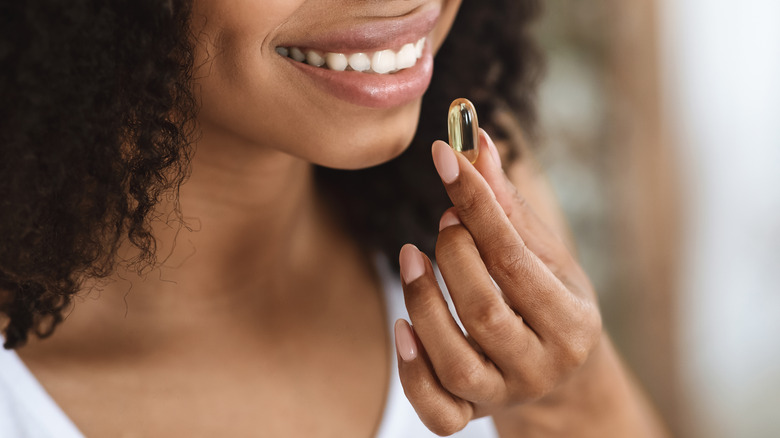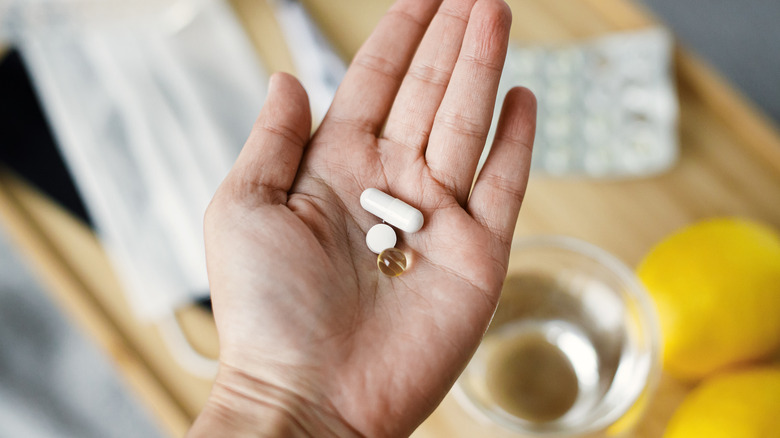This Is How To Tell If Your Vitamins Are Actually Working
When it comes to getting an ample supply of micronutrients, vitamins and minerals are key. Every part of your body, from the skin down to the teeniest cells, needs micronutrients for optimal health. According to Healthline, taking a multivitamin is one of the simplest ways to get a variety of vitamins and minerals. In addition, some multivitamins may have herbs, amino acids, and fatty acids, which all cater to your well-being in various ways.
Healthy Cell mentioned that most multivitamins include vitamins A, B, C, D, E, and K. Some of the best multivitamins may also have minerals like zinc, iodine, selenium, manganese (or magnesium), chromium, and molybdenum.
While taking a multivitamin once or twice a day (depending on the instructions) can prove beneficial, it may be hard to tell if it's working right away. Here we'll explore a few things you can do to ensure your body is reaping all the benefits.
Recommended daily amounts
Familydoctor.org suggests aiming for the recommended daily amounts (RDAs) for key nutrients like calcium, potassium, magnesium, and vitamins A, C, D, and E. These RDAs are for the average adult American who consumes roughly 2,000 calories a day. Choosing the right diet that supports a good supply of vitamins and minerals can be helpful. The following are ways you can get the recommended amounts through your diet.
Non-fat or low-fat yogurt, cheese, and milk, as well as fish, beans, spinach, and oatmeal are great sources of calcium that can help you achieve the goal of getting 1,136 milligrams each day (via Familydoctor.org). For potassium, 4,044 milligrams are recommended and can be found in potatoes, beans, yogurt, low-fat or skim milk, fruit, fish, and tomato-based products. You'll want to aim for 380 milligrams of magnesium, an iron-rich nutrient that is in vegetables, bran cereal, beans, and nuts.
Shoot for 700 to 900 micrograms of vitamin A by eating organ meats, vegetables, and cantaloupe (per Familydoctor.org). For vitamin C, 65 to 90 milligrams is the goal and it's in many fruits and vegetables. Adults should receive 600 International Units (IU) of vitamin D and those 70 and older should receive 800 IU. Sources of vitamin D include fatty fish, cheese, fortified milk, fortified orange juice, fortified cereal, and fortified yogurt. The daily recommended amount of vitamin E is 15 mg and you can find it in nuts and seeds, turnip greens, peanut butter, spinach, avocado, and tomato-based products.
Be aware of vitamin absorption pitfalls
Just because you're taking vitamins and minerals doesn't mean your body is absorbing them properly, which can be particularly frustrating if you're spending a good amount of money on supplements. Here are a couple of significant reasons why this is happening.
For starters, your supplements may not be disintegrating quickly enough. A 20-minute biological time clock of sorts starts as soon as you swallow a pill (via Calton Nutrition). If the pills don't break down within that time frame, the body won't be able to make good use of the vitamins and minerals it contains.
Some companies use shellac, wax, or hydroxypropylmethylcellulose (say that five times fast) to ensure moisture doesn't seep in and diminish the shelf life of supplements. Unfortunately, this prevents solubility, and consequently, the supplements may not disintegrate fast enough for us to absorb them, according to Calton Nutrition. Another common way solubility is affected is due to the extra amount of binders, fillers, and flow agents that can alter the absorption rate. Also, sweeteners often found in chewable, liquid, and gummy vitamins can ultimately block nutrient absorption.
Measure your progress
When starting a new vitamin regimen, you might look for physical clues that they're working, such as analyzing the whites of your eyes, paying more attention to your energy levels, or studying your sleep patterns. All of these practices are good things to pay attention to. Nano Nutra provided tips that can help you keep track of what you find.
Pick up a notebook or journal and write about how you feel right now. This includes both your well-being, like mental and emotional health, as well as any aches, pains, or discomfort. Also, note anything about your appearance that you find important. After taking your vitamins and minerals regularly, carve out some time once or twice a week to journal new developments. Asking your doctor to check for vitamin deficiencies, hormonal imbalances, food sensitivities, and other issues can also help as you try to fill any nutritional gaps.



